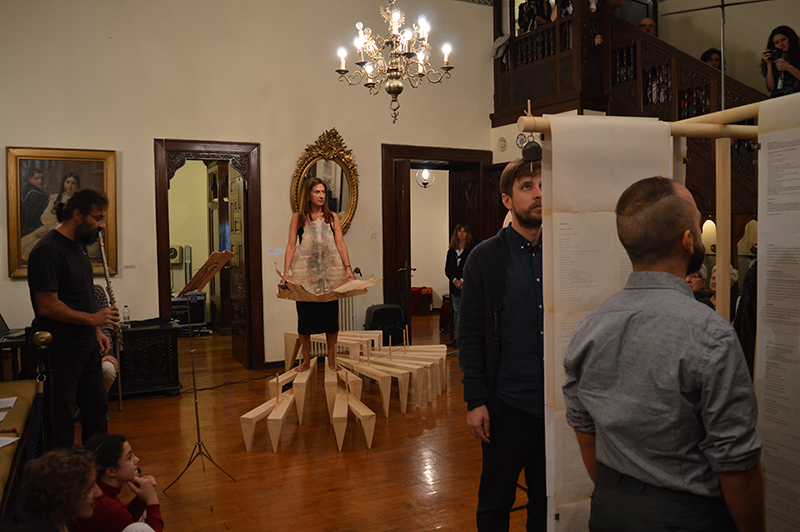“Poetry is a response to stimuli, which touch, permeate and agitate the body.”
In her writings, Phoebe Giannisi asks about the meeting point between poetry and the natural world, she explains that “the so called ‘natural’ world is [her] window to poetry”, that “the bodily senses are mediated by their expressiveness through constructed language, which means poetry or philosophy, the first ax that dug this world.”
I am referring to the simplest stimuli, the contact with other beings, with the earth and the place, with the everyday, with life, with memory, with others’ poetry, with what comes from the outside, triggering emotion. Inspiration is a kind of inhalation of the other, that is returned to the outside by a construction made with feeling and thinking. Every part and every species that compose the Chimera has its own autonomy, yet all function evenly as a network.
As I grow up, I have come to realize that for me poetry, writing and vocalization constitute also a form of therapy. As Eleni Stecopoulos aptly puts it in her book Visceral Poetics, poetry is a kind of healing practice, it has to do with illness, it is visceral, sympathetic, it is a form of care in order to be. For me, the practice of handwriting as well as writing itself is such an activity, just like oral recitation is a ritual of healing. More and more consciously, as I practice poetry, I invent a ritual that makes me forget. The cicada that metabolizes the juice is such a vain momentary effort that heals pain without curing.
“The dense minimal poems of Giannisi explore with arresting directness the relationship between language and the elements of the natural world with a language which is always subtle and inornate, skillfully bare,” as Haris Vlavianos aptly put it. What is the relationship between art and the urban landscape? Where does poetry meet the natural world in your writings?
Already from my early writings, one could easily discern a quest to utter the experience of a relationship, either enthusiastic or mournful, to the natural element. Is it a kind of return to the archaic? Is this a kind of celebration to beauty? Or is it rather a kind of grief, a desperate attempt to bring the being out of oblivion?
This “archaism” should not be dissociated from language and representation. The so-called ‘natural’ world (along with the questions this term poses in the 21st century in relation to the construction of the natural as part of the cultural) is my window to poetry. But the bodily senses are mediated by their expressiveness through constructed language, which means poetry or philosophy, the first ax that dug this world.
Svenbro writes about the first samples of writings, the inscriptions put in verse on ancient Greek statues, where the first person was used to refer to the object bearing the inscription: “Mr. Brugmann accepts the hypothesis that the Greek ‘ego’ is descended from an Indo-European noun, eg(h)om, meaning Hierheit, “hereness”.” (p. 73, Phrasikleia). I consider this etymology of the ‘I”, “ego”, as related to locality, to “hereness”, a very appealing interpretation, so suitable that it looks fake, for my work. If the “I” is nothing less than a ‘here’, then the voice in poetry expresses nothing but this ‘here’, yet through the multiplicity of subjects, those Others, that dwell ‘here’ at that very moment. Place and language together, language as a place.
If science answers a question that has been formulated, then art responds to questions that never arose, to a kind of a call. In poetry, this is the call of the Other. In the urban landscape, the Other, different but also similar, is related to the human and the social. The urban space renders the human multiplicity; an immense and living complex environment, with its own built typology, its patterns of repetition and ritual, its singular events. Urban space offers the vital perspective of meeting different subjectivities, carrying a polyphony of their own myths and voices.. That’s why situationalists reflect on the city as the primary place for the theater of life, where everyone can playfully participate. City wandering and oral dealings with people enrich experience in the most surprising and joyful way; they also reveal human pain, social inequalities and struggles. Last but not least, the urban space is also the area of publication, where the poet returns to the public what may have been created somewhere in the loneliness, outside.
Phoebe Giannisi is part of the panel „Mythen als performativer Akt“ (18.10), together with Dagny Gioulami (CH), Dirk Uwe Hansen (DE) and Jochen Schmidt (DE).
Read the whole interview online
